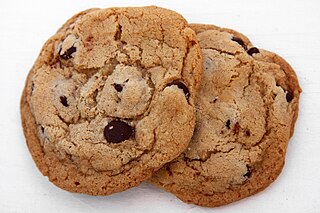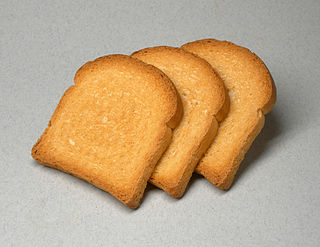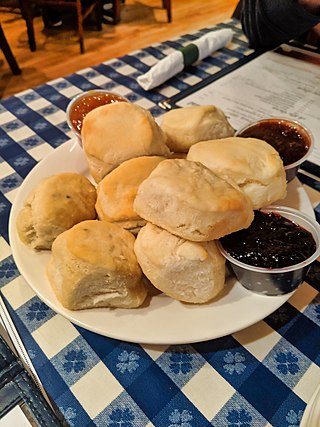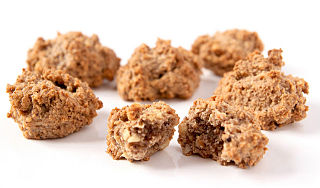Biscotti are Italian almond biscuits from Prato, Italy
Biscotti may also refer to:
- Biscotti Regina, small Italian biscuits
- Enrico Biscotti Company, bakery and restaurant in Pittsburgh T
- Rossella Biscotti, (born 1978), Italian visual artist
Biscotti are Italian almond biscuits from Prato, Italy
Biscotti may also refer to:

A cookie or biscuit is a baked snack or dessert that is typically small, flat, and sweet. It usually contains flour, sugar, egg, and some type of oil, fat, or butter. It may include other ingredients such as raisins, oats, chocolate chips, or nuts.

A biscuit, in many English-speaking countries, including Britain, Ireland, Australia, New Zealand, India, and South Africa but not Canada or the US, is a flour-based baked and shaped food item. Biscuits are typically hard, flat, and unleavened. They are usually sweet and may be made with sugar, chocolate, icing, jam, ginger, or cinnamon. They can also be savoury, similar to crackers. Types of biscuit include biscotti, sandwich biscuits, digestive biscuits, ginger biscuits, shortbread biscuits, chocolate chip cookies, chocolate-coated marshmallow treats, Anzac biscuits, and speculaas.

A rusk is a hard, dry biscuit or a twice-baked bread. It is sometimes used as a teether for babies. In some cultures, rusk is made of cake, rather than bread: this is sometimes referred to as cake rusk. In the UK, the name also refers to a wheat-based food additive.

Biscotti (, Italian:[biˈskɔtti]; lit. 'biscuits'; are Italian almond biscuits originating in the city of Prato, in Tuscany. They are twice-baked, oblong-shaped, dry, and crunchy. In Italy, they are known as cantucci, biscotti di Prato or biscotti etruschi and may be dipped in a drink, traditionally Vin Santo. Smaller biscotti may be known as biscottini or cantuccini. In Italian, the word biscotti encompasses all kinds of biscuits or cookies.
Amaretto is an almond-flavored Italian liqueur.

Lazzaroni is the brand name related to several biscuits and bakery products manufactured by the Italian company D. Lazzaroni & C. Spa.

Metaphysical Interior with Biscuits is a 1916 painting by Italian metaphysical painter Giorgio de Chirico. It is one of the earliest editions in a series of works that extended late into Chirico's career.

Koulourakia or Koulouria, or kerkele in Pontic Greek, are a traditional Greek dessert, typically made around Easter to be eaten after Holy Saturday.

In the United States, a biscuit is a variety of baked bread with a firm, dry exterior and a soft, crumbly interior. In Canada it sometimes also refers to this or a traditional European biscuit. It is made with baking powder as a leavening agent rather than yeast, and at times is called a baking powder biscuit to differentiate it from other types. Like other forms of bread, a biscuit is often served with butter or other condiments, flavored with other ingredients, or combined with other types of food to make sandwiches or other dishes.
Biscotti regina or reginelle are small Sicilian biscuits, coated with sesame seeds. They are typical of the province of Palermo but are also widespread in other Sicilian provinces. These cakes taste halfway between sweet and salty (savoury), reminiscent of their roots Arab cuisine.

Bruttiboni, also known as mandorlati di San Clemente and brutti ma buoni, is a type of hazelnut or almond-flavoured biscuit made in Prato, Tuscany, and many other cities. These biscuits are made by incorporating meringue, which is an egg white and sugar mixture, with roasted chopped nuts. The biscuits are crunchy on the outside with a soft texture in the middle. As with many other Italian biscuits, their origin is disputed, but they have been made since at least the mid-1800s.

Caffè Vittoria is an Italian cafe located on Hanover Street in the North End neighborhood of Boston, Massachusetts, United States. The cafe features four levels, three liquor bars, and a cigar room.

Paximathia, also spelt paximadia (plural), or paximadi/paximathi (singular), is a hard bread of Greek origin, similar to rusk, that is prepared with whole wheat, chick pea or barley flour. It has been referred to as being similar to biscotti or as a type of biscotti. Paximathia is a common food in Greece and many Greek bakeries sell the bread, which is often served as a breakfast food with marmalade or cheese. Paximathia is purveyed also in Greek specialty stores in many areas of the United States.

Rossella Biscotti is an Italian visual artist best known for her installations, performances and video.

The Military Biscuit is a food component of the Swiss army.

DiCamillo Bakery is an Italian American family-run bakery chain founded in 1920 in Niagara Falls, New York. It has locations in Niagara Falls, Williamsville, and Lewiston. It is known mainly for its biscotti.
Rossella is a female given name. Notable people with the name include:

Camporelli or biscotti Camporelli is a light biscuit made with flour, sugar and eggs, and then baked twice. They are characterised by their round, long shape, crispy edges and golden colour, as well as the lack of fat, such as butter. They are used in various tiramisu recipes, served with ice cream or eaten alone.